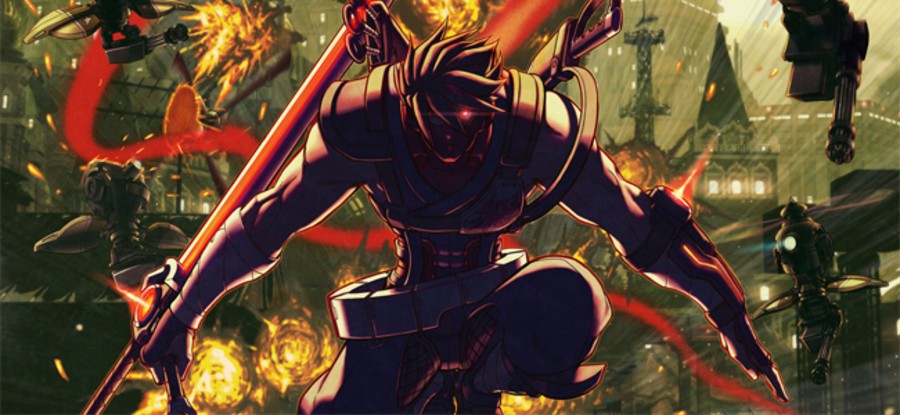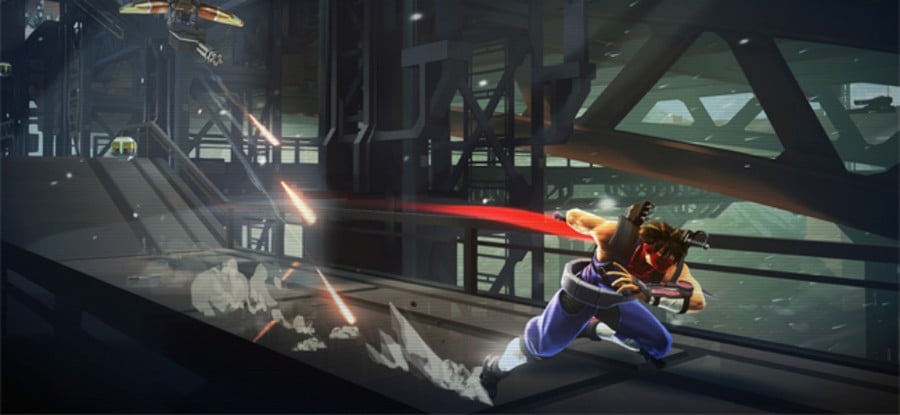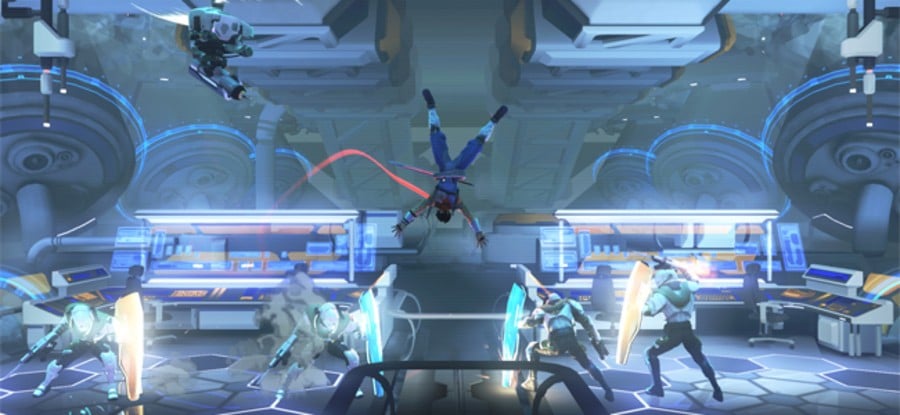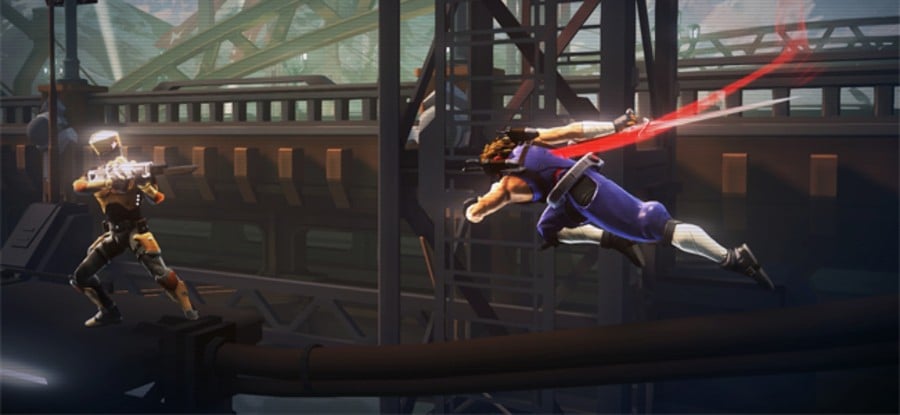
It’s all change at Double Helix Games, with online retailer Amazon recently announcing that it had acquired the company outright. Fortunately, the takeover has not disrupted development on the studio’s promising Strider reboot, which is set to cut your console of choice to pieces on 18th February in North America and 19th February in Europe. With the PlayStation 4 and PlayStation 3 release fast approaching, we caught up with design director and industry veteran Tony Barnes to talk a little more about the fast approaching reboot, and how the team’s taken steps to successfully resurrect an industry icon.

Push Square: To get started, can you talk a little bit about how this project came about? Why do you feel that Capcom selected you for the project, and what is that drew you to it in the first place?
Tony Barnes: I think that our passion and understanding of the franchise is what sold Capcom on working with us. We have a lot of Capcom fans in the building, as well as some people who actually worked at Capcom in the 80s and 90s. Personally, I’ve been making games for decades and always wanted to make “something like Strider”. When asked if I wanted to work on a new Strider game, there was no way I was going to pass up on 20 plus years of dreaming.
PS: Strider is a series with a vocal and a dedicated fanbase, with some fans responding negatively to the news that a Western studio has taken the reins. What would you say to reassure those slightly more cautious voices?
TB: As a fan myself, I can understand. There can be a lot of worry when it comes to the development of such a beloved series. Internally, we’re incredibly passionate fans and take the responsibility very seriously. Not only did we do an enormous amount of homework, design, and iteration, [but] we also listened to the public, even if they knew it or not. We read every forum post, article, FAQ, blog, everything – good and bad – to give us the best chance of making this Strider game the best that it can be. We’re huge fans ourselves, and some of us have been waiting a long time for a new Strider game, as well.
PS: You’ve developed the game in conjunction with Capcom Osaka. Can you talk a little bit about their input, and what challenges you’ve faced working with a team overseas? What have you learned from the collaboration?
"We collaborated very closely with the team in Osaka and they’ve provided great insight into the Strider universe, Hiryu in particular"
TB: We collaborated very closely with the team in Osaka and they’ve provided great insight into the Strider universe, Hiryu in particular. Their ideas and feedback have proven invaluable. I’d say the biggest challenges have been mostly operational: time differences (we’re 17 hours behind Japan in California) and language barrier (waiting for translation of text or spoken word). In the end, each side wanted to ensure that this new Strider game had the correct feel and paid proper homage to the Striders of the past, while appealing to a modern audience. Always being aligned with the same goal makes any working relationship smoother.
PS: Series creator Kouichi Yotsui has publicly acknowledged the product in the media, but have you had any additional feedback from him? Has he given any guidance on the game? How do you expect him to react to the final product?
TB: The original creator – I’m a big fan, by the way – has not been involved with the development of the game, but has seen it and I’ve heard is pleased with what he saw. We had a great group of collaborators from Capcom Osaka, though, including the lead character artist from Strider 2 and the lead designer of many of the Ghosts 'n Goblins games as well as other classic side-scrollers.

PS: Why have you decided to adopt a more open world approach for this re-telling? How are you effectively balancing the fast-paced action of the original games with the Metroidvania-esque exploration elements?
TB: The original games were hard-as-nails arcade games, made to give you a concentrated dose in a short amount of time. Outside of the arcade, a 30-minute game doesn’t make as much sense, so we looked at what type of game [could be] built upon Strider’s core abilities and made the most sense. A more open action adventure was unanimously agreed upon both within Double Helix and Capcom Japan. Once it was decided to take this approach, we laid out a schedule for unlocking Strider Hiryu’s abilities and how they coincide with the narrative. Every ability Strider has and unlocks was designed and implemented with the core of Strider in mind: fast and fluid combat. If something slowed down the player, it was minimized or taken out, to maintain that Strider "feel”.
"A fully-powered up Strider Hiryu is a visual riot of destruction and joyous to play and watch"
PS: As an action game, can you talk about some of Strider Hiryu’s new abilities? Will the character start out relatively underpowered throughout the game, and pick up new moves along the way?
TB: Unlike a lot of games in this genre, we didn’t want you to start out uber-powerful, then have that all stripped away. Instead, you start out very powerful and continue to become more and more powerful. In the end, a fully-powered up Strider Hiryu is a visual riot of destruction and joyous to play and watch.
PS: Are there any abilities that were planned for the game that got cut? Why did you make the decision to take them out?
TB: Most games have things that are cut, it’s the nature of the beast. Some things were nice ideas on paper but don’t work in the actual game, other things just don’t fit the core of what you’re making. For Strider, if something didn’t fit the 'fast and fluid combat' game pillar, it was iterated upon until it fit or cut. It was important to maintain that lightning fast killing machine feel of the original Strider games.
PS: We’d love to hear more about the bosses in this game. Will we see any familiar foes making a return?
TB: There are a lot of familiar faces in this Strider game, as well as enemies that pay homage to past Strider games and other Capcom titles. They’ve all been designed – or re-imagined – from the ground-up for this Strider, but the team was very keen to retain the proper look and feel for each and every character. The enemies in this Strider live a little bit longer than previous Strider games, so their attack patterns are more robust, providing them with opportunities for a bit more character and challenge for players.

PS: How difficult was finding the right tone for the art style? What were the inspirations behind the scanline overlay? What have you done to make the Hiryu model feel modern, but also appealing to fans of the original games?
TB: We went through a few different styles for art, iterating towards the one that fit this new Strider game. Since Hiryu moves so fast, it was important to have a bold and interesting style that fit the rapid pace that you chew up the environment at. Double Helix’s art director Jon Tucci insisted on bold composition, unique silhouettes, and a hierarchy of detail as our hallmarks. This direction drove us towards a very graphic style that favours form over little details and visual noise. The scanline effect came about initially as a nod to the 8 and 16-bit era that spawned the original game, but also enhances the surface quality of the visuals.
The Hiryu model was one of the first things designed. It was designed by Capcom’s art director Sho Sakai in the Osaka office, and every little detail was toiled over each step of the way, from paper to 3D to in-game. The Hiryu in this new Strider is an evolution of Hiryu, as each one has been in every previous game. I personally love the hardened armour Sakai-san designed into this modern Hiryu and await the cosplay.
"The vision for Strider was established early on between Double Helix and Capcom and we maintained a razor-like focus on executing that vision"
PS: This isn’t the first Strider reboot that’s been in development, with GRIN famously working on prototypes back in the day. Were you privy to any of that studio’s work, and did it influence your vision in any way?
TB: The team at Double Helix absorbs any and all information available when we take on a project. For Strider, we logged countless hours with each and every game in the series, as well as other Capcom games and games in the genre, to ensure that we had it embedded into our DNA. The vision for Strider was established early on between Double Helix and Capcom and we maintained a razor-like focus on executing that vision.
PS: What’s next for the Strider franchise? Are there broader plans for a bigger retail sequel if this performs well?
TB: You’ll have to ask Capcom about that! Our current focus here at Double Helix is to deliver the best experience with this new Strider game.
PS: How have you found working simultaneously on the PS4 and PS3? What advantages does the next-gen system bring?
Our in-house technology enables us to conduct cross-platform development relatively easily. For Strider, we are utilising the power of the PS4 to run the game in 1080p at 60 frames-per-second, with improved lighting, higher resolution models, and enhanced visual effects.

PS: The game looks like it would scale well to a handheld, so are there any plans for a PlayStation Vita release?
TB: At the moment our primary focus is to deliver a high quality product for all of the announced platforms.
PS: This is your second reboot in a fairly short span of time. What’s the best part of resurrecting these old franchises for a new generation? Are there any classics in particular that you’d love to work on, or are you itching to create a new brand of your own?
TB: It’s been incredibly exciting personally and the entire studio feels very fortunate to have been given this opportunity. Taking classic games and breaking them down to their purest essence, then building them back up has been incredibly rewarding. Personally, this has been a dream of mine for over 20 years. To take Strider and pay homage to those great arcade games of old and introduce it to a new audience is a great honour and we don’t take it lightly.
As our studio head Patrick Gilmore puts it, we are absolutely open to more reboots in the future, but are looking beyond established and classic franchises, leaning towards more original creations. Double Helix will have exciting news in the future, and we look forward to spreading the word when the time is right.
Do you think that Double Helix's interpretation of Strider looks sharp, or is it cutting you up in the wrong way? Which platform are you planning to play the game on, and are you disappointed that there's no Vita version on the way? Stick your Cypher in the comments section below.





Comments 3
O man I want this game so badly! It is going to be so much fun to stream
I really looking forwards to Strider which I'll be buying for the PlayStation4, the PS3 version comes with a download code for the original games. I think that's a pre-order bonus but I'm not totally sure on that, so I might also pre-order the PS3 version for the original games.
Great interview! I don't think I've ever heard a developer sound so intent on staying true to the originals. Very promising. I think it will be a great game.
Tap here to load 3 comments
Leave A Comment
Hold on there, you need to login to post a comment...